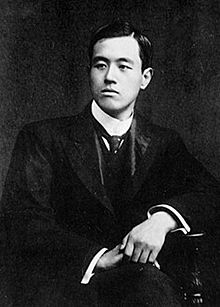1902 Ōtani expedition

The1902 Ōtani expeditionwas a Japanese archaeological expedition to a series ofSilk Roadsites in theTaklamakan Desert,led by CountŌtani Kōzuiand lasting from 1902 until 1904. The expedition aimed to study the earlytransmission of Buddhismthrough Central Asia into China, and conducted major excavations in theKuchaarea.
Background
[edit]Between 1900 and 1902, Ōtani, a Buddhist priest, lived in London studying Western theology and came into contact with a number of European explorers includingAurel SteinandSven Hedin.Hedin had made hisfirst expeditionto Tibet in 1893, and had brought back a large number of documents from hissecond expedition,while Stein had recently completed hisfirst expeditionin the Taklamakan Desert. Having learned of the results of these expeditions, Ōtani decided to return to Japan by land via Tibet, with the intent of researching the spread of Buddhism through Central Asia.[1]
Expedition
[edit]
The expedition consisted of Ōtani, as the lead, and four other Japanese scholars -Honda Eryu,Inoue Koen,Hori Kenyu,andWanatabe Tesshin.The group met inSt. Petersburgin August 1902, and traveled through the Russian Empire toKashgarin far western China. Here, the group split; Ōtani, Inoue and Honda were to return to Japan via India, while Hori and Wanatabe would remain in Tibet to study ancient sites.[2]
Both groups headed along the edge of the Taklamakan Desert toYarkand,then south-west into the mountains toTashkurgan.Here, Ōtani's group left to head south through theMintaka Passtowards India, while the others returned to Yarkand and traveled south and east around the desert toHotan,where they stopped to excavate historic sites. They crossed the desert to the north, visitingAksuandTurfan,before turning back to Kashgar. After a short rest, they retraced their steps throughTumxukand arrived atKucha,where they set up a base from which to investigate local sites including theKizil Caves,Kumtura Caves,Duldulokur,andSubashi.After four months at Kucha, they headed eastwards through China to return to Japan.[2]
The group focused their work on sites in the Kucha area, as Stein hadrecently completedresearch at Khotan, and a German group wasstill workingat Turfan.[2]TheKizil Caveswere first discovered and explored in 1902-1904 by Tesshin Watanabe ( độ biên triết tín ) and Kenyu Hori ( quật hiền hùng ), funded byCount Otani,but the expedition left hurriedly after four months of exploration in the area of Kucha, following a local earthquake.[3][4]
-
Kizil Caves,Small Ravine (Cave 175-190), as photographed by the Otani Expedition 1902-1904
-
Otani Expedition returning from Dunhuang to Holland
Subsequent expeditions
[edit]Following Ōtani's return to Japan, he succeeded his father as 22nd Abbot of theNishi Honganjisect. While this greatly limited his own ability to travel, it gave him the opportunity to fund and organize future expeditions.[5]In 1908, Ōtani dispatched asecond expedition to the Taklamakan,[6]followed bya third in 1910.[7]
Notes
[edit]- ^Galambos, Imre."Otani Kozui's 1910 visit to London"(PDF):1. Archived fromthe original(PDF)on 2020-12-08.Retrieved2012-10-23.
{{cite journal}}:Cite journal requires|journal=(help) - ^abc"IDP Japanese Collections".2005.Retrieved23 October2012.
- ^"It is the merit of Kenyu Hori and Tesshin Watanabe to have discovered and first examined the cave complex of Kizil. Unfortunately, the efforts and findings of this examination have been destroyed by an earthquake that scared away the Japanese scholars, which enabled the Germans to uncover, carry away and come out with the treasures of this site a short while afterwards (Klimkeit, 1988, 38)" inFellner, Hannes A. (2007). "The Expeditions to Tocharistan". In Malzahn, Melanie (ed.).Instrumenta Tocharica(PDF).Indogermanische Bibliothek. Heidelberg: Universitätsverlag Winter. Note 39, p. 25.
- ^"IDP JAPANESE COLLECTIONS".idp.bl.uk.Archived fromthe originalon 2021-10-25.Retrieved2021-02-12.
- ^Galambos (2012), pp. 114–5.
- ^Galambos (2012), p. 115–6.
- ^Galambos (2012), p. 117–8.
References
[edit]- Galambos, Imre;Kitsudō, Kōichi (February 2012)."Japanese exploration of Central Asia: The Ōtani expeditions and their British connections".Bulletin of the School of Oriental and African Studies.75(1): 113–134.doi:10.1017/S0041977X1100125X.


